
Hang gliding is an air sport or recreational activity in which a pilot flies a light, non-motorised, heavier-than-air aircraft called a hang glider. Most modern hang gliders are made of an aluminium alloy or composite frame covered with synthetic sailcloth to form a wing. Typically the pilot is in a harness suspended from the airframe, and controls the aircraft by shifting body weight in opposition to a control frame.

A ladder is a vertical or inclined set of rungs or steps commonly used for climbing or descending. There are two types: rigid ladders that are self-supporting or that may be leaned against a vertical surface such as a wall, and rollable ladders, such as those made of rope or aluminium, that may be hung from the top. The vertical members of a rigid ladder are called stringers or rails (US) or stiles (UK). Rigid ladders are usually portable, but some types are permanently fixed to a structure, building, or equipment. They are commonly made of metal, wood, or fiberglass, but they have been known to be made of tough plastic.

A climbing harness is a device which allows a climber access to the safety of a rope. It is used in rock and ice climbing, abseiling, and lowering; this is in contrast to other activities requiring ropes for access or safety such as industrial rope work, construction, and rescue and recovery, which use safety harnesses instead.
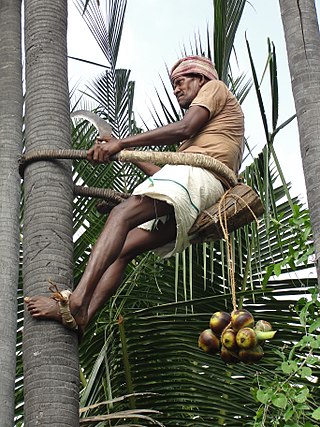
Tree climbing is a recreational or functional activity consisting of ascending and moving around in the crowns of trees.

A tree house, tree fort or treeshed, is a platform or building constructed around, next to or among the trunk or branches of one or more mature trees while above ground level. Tree houses can be used for recreation, work space, habitation, a hangout space and observation. People occasionally connect ladders or staircases to get up to the platforms.

Belaying is a variety of techniques climbers use to create friction within a climbing system, particularly on a climbing rope, so that a falling climber does not fall very far. A climbing partner typically applies tension at the other end of the rope whenever the climber is not moving, and removes the tension from the rope whenever the climber needs more rope to continue climbing.

An aerial work platform (AWP), also known as an aerial device, elevating work platform (EWP), aerial lift, cherry picker, bucket truck or mobile elevating work platform (MEWP) is a mechanical device used to provide temporary access for people or equipment to inaccessible areas, usually at height. There are distinct types of mechanized access platforms and the individual types may also be known as a "cherry picker", "boom lift" or "scissor lift".

A dive boat is a boat that recreational divers or professional scuba divers use to reach a dive site which they could not conveniently reach by swimming from the shore. Dive boats may be propelled by wind or muscle power, but are usually powered by internal combustion engines. Some features, like convenient access from the water, are common to all dive boats, while others depend on the specific application or region where they are used. The vessel may be extensively modified to make it fit for purpose, or may be used without much adaptation if it is already usable.

A ropes course is a challenging outdoor personal development and team building activity which usually consists of high elements, low elements, or some combination of the two. Low elements take place on the ground or above the ground. High elements are usually constructed in trees or made of utility poles and require a belay for safety.

A hunting blind (US), hide or machan is a concealment device or shelter for hunters or gamekeepers, designed to reduce the chance of detection by animals. There are different types of blinds for different situations, such as deer blinds and duck blinds. Some are exceedingly simple, while others are complex. The legality of various kinds of blinds may vary according to season, state and location.

A child safety seat, sometimes called an infant safety seat, child restraint system, child seat, baby seat, car seat, or a booster seat, is a seat designed specifically to protect children from injury or death during vehicle collisions. Most commonly these seats are purchased and installed by car owners, but car manufacturers may integrate them directly into their vehicle's design and generally are required to provide anchors and ensure seat belt compatibility. Many jurisdictions require children defined by age, weight, and/or height to use a government-approved child safety seat when riding in a vehicle. Child safety seats provide passive restraints and must be properly used to be effective. However, research indicates that many child safety restraints are often not installed or used properly. To tackle this negative trend, health officials and child safety experts produce child safety videos to teach proper car seat installation to parents and caregivers.
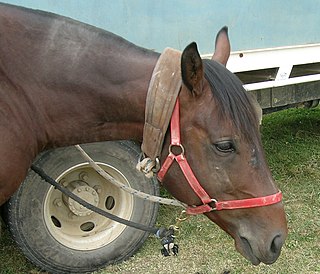
An animal collar is a device that attaches to the neck of an animal to allow it to be harnessed or restrained.
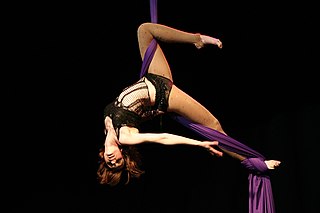
Aerial silks is a type of performance in which one or more artists perform aerial acrobatics while hanging from a specialist fabric. The fabric may be hung as two pieces, or a single piece, folded to make a loop, classified as hammock silks. Performers climb the suspended fabric without the use of safety lines and rely only on their training and skill to ensure safety. They use the fabric to wrap, suspend, drop, swing, and spiral their bodies into and out of various positions. The fabric may also be used to fly through the air, striking poses and figures. Some performers use rosin on their hands and feet to increase the friction and grip on the fabric. Aerial silks is a demanding art and requires a high degree of strength, power, flexibility, courage, stamina, and grace to practice.

Kite landboarding, also known as land kiteboarding or flyboarding, is based on the sport of kitesurfing, where a rider on a surf-style board is pulled over water by a kite. Kite landboarding involves the use of a mountain board or landboard, which is essentially an oversized skateboard with large pneumatic wheels and foot-straps. Kite landboarding is a growing sport, and there are several competitions. Kite landboarding is attracting growing publicity although it is not yet as popular or as well known as kitesurfing.

A safety harness is a form of protective equipment designed to safeguard the user from injury or death from falling. The core item of a fall arrest system, the harness is usually fabricated from rope, braided wire cable, or synthetic webbing. It is attached securely to a stationary object directly by a locking device or indirectly via a rope, cable, or webbing and one or more locking devices. Some safety harnesses are used in combination with a shock-absorbing lanyard, which is used to regulate deceleration and thereby prevent a serious G-force injury when the end of the rope is reached.

Deer hunting is hunting deer for meat and sport, an activity which dates back tens of thousands of years. Venison, the name for deer meat, is a nutritious and natural food source of animal protein that can be obtained through deer hunting. There are many different types of deer around the world that are hunted for their meat. For sport, often hunters try to kill deer with the largest and most antlers to score them using inches. There are two different categories of antlers. They are typical and nontypical. They measure tine length, beam length, and beam mass by each tine. They will add all these measurements up to get a score. This score is the score without deductions. Deductions occur when the opposite tine is not the same length as it is opposite. That score is the deducted score.

Window cleaning, or window washing, is the exterior cleaning of architectural glass used for structural, lighting, or decorative purposes. It can be done manually, using a variety of tools for cleaning and access. Technology is also employed and increasingly, automation.
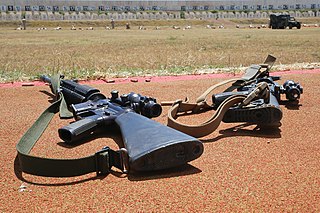
In the context of firearms, a sling is a type of strap or harness designed to allow a shooter to conveniently carry a firearm on their body, and/or to aid in greater hit probability by allowing the firearm to be better braced and stabilized during aiming. Various types of slings offer their own advantages and disadvantages, and can generally be divided into several categories.

Human factors in diving equipment design are the influences of the interactions between the user and equipment in the design of diving equipment and diving support equipment. The underwater diver relies on various items of diving and support equipment to stay alive, healthy and reasonably comfortable and to perform planned tasks during a dive.
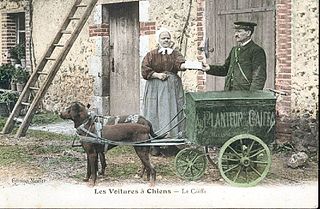
A dog harness is a piece of equipment consisting in part of straps that surround the dog’s torso. It is used to guide, hold, and lift the dog or to utilise its pulling power. It reduces tension on the neck when they pull, and provides free breathing during daily walks. In sports such as mushing and skijoring, where the dog's pulling power is utilized, the harness provides effective use of force while maintaining freedom of movement. These aforementioned kinds of harnesses differ from pet harnesses in that they are specifically designed in order to allow or support a dog in the completion of a working task.





















